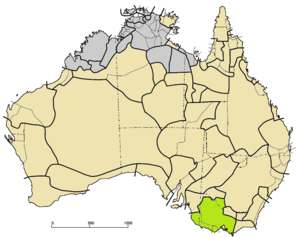Kulinic languages
The Kulinic languages form a branch of the Pama–Nyungan family in Victoria (Australia). They are:
| Kulinic | |
|---|---|
| Kulin–Bunganditj | |
| Geographic distribution | Victoria (Australia) |
| Linguistic classification | Pama–Nyungan
|
| Subdivisions | |
| Glottolog | kuli1256[1] |
 Kulinic languages (green) among other Pama–Nyungan (tan). Along the coast, the three groups are (west to east) Drual, Kolakngat, Kulin. | |
Warrnambool is Kulinic[2] and may be Drual, but is too poorly attested to be certain.[3] Gadubanud was a dialect of either Warrnambool or Kolakngat.[4] Several poorly attested interior Kulinic languages, such as Wemba-Wemba, are listed in the Kulin article.
The three branches of Kulinic are not close; Dixon treats them as three separate families.
Bibliography
- Dixon, R. M. W. 2002. Australian Languages: Their Nature and Development. Cambridge University Press
gollark: Or is it 27th August? probably that.
gollark: Just unban heavpoot and forget about it until 27 August.
gollark: You're esobot.
gollark: I KNEW IT
gollark: IT BECAME SENTIENT
References
- Hammarström, Harald; Forkel, Robert; Haspelmath, Martin, eds. (2017). "Kulin–Bunganditj". Glottolog 3.0. Jena, Germany: Max Planck Institute for the Science of Human History.
- Bowern, Claire. 2011. "How Many Languages Were Spoken in Australia?", Anggarrgoon: Australian languages on the web, December 23, 2011 (corrected February 6, 2012)
- Barry Blake (2003) The Bunganditj (Buwandik) language of the Mount Gambier Region, p 17 ff.
- S71 Gadubanud at the Australian Indigenous Languages Database, Australian Institute of Aboriginal and Torres Strait Islander Studies
This article is issued from Wikipedia. The text is licensed under Creative Commons - Attribution - Sharealike. Additional terms may apply for the media files.